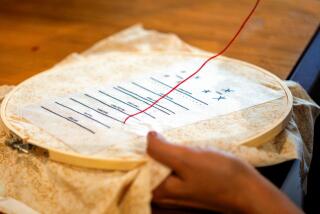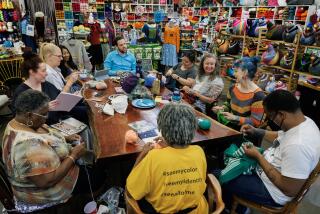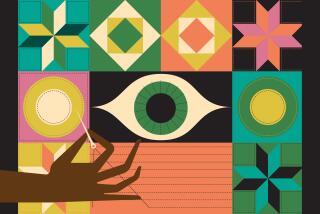Close-Knit Groups : Love of Quilting Weaves Women’s Lives Together
- Share via
Promptly at 9 a.m. every Tuesday, the members of Ojai Quilters Anonymous drag five eight-foot-long frames out of the closet, unfold metal chairs and set to work.
With heavily calloused fingers, the 10 women who gathered one recent Tuesday guided tiny needles along the curving, penciled patterns--taking four, sometimes five or six stitches at a time as they attached finished quilt tops to backings, fixing in place the batting, or padding, in between.
A good number of the group’s 20 members are in their mid- to late 30s, but most are in their 60s and 70s--a few in their 80s. And they all share a palpable passion for the exacting craft of quilting. It’s almost an addiction, too--hence the group’s name.
They say quilting has been woven into their lives for myriad reasons: for the creativity it allows and demands, for the camaraderie, for its soothing, therapeutic effect and for the connection it provides to a centuries-old legacy in America.
“It’s the best therapy in the world to sit down and piece a quilt,” Lucille Miller, 78, a 50-year Ojai resident, says with conviction. Miller, who has a wry sense of humor and a quick smile, has quilted regularly for 11 years.
“It’s something that your kids will enjoy,” Fran Korzun, 80, of Ojai says as she gingerly feels for a needle pushed through her quilt top. “The quilt will be around when we’re gone.”
Ojai quilter Sue Gustafson, 38, an exceedingly tidy and well-kept woman much admired by her fellow quilters for her precise stitches, chimes in half seriously: “It makes us immortal.”
Ojai Quilters Anonymous was organized in the early 1970s by two young women and, since its inception, almost 100 quilts have been lovingly assembled and finished during weekly meetings. Each member accumulates hours as they quilt together, and the one with the most hours--about 200 are needed--has her quilt put on the frame next to be quilted.
The quilts evoke memories of hardy pioneer women who rattled across vast plains in covered wagons from the safety and familiarity of New England to carve out new lives in then-unsettled Western territories.
But even under the modern glare of fluorescent lights and atop industrial pile carpeting in the small, modest room at the Jack Boyd Community Center in Ojai where they meet, little has changed from the early days of stitching and quilting by firelight.
Indeed, in the dozens of quilting groups throughout Ventura County, it is much the same as in Ojai. In Southern California alone, there are 48 guilds (to which the clubs may belong), each with anywhere from a few dozen members to a few hundred.
The conversations, too, at the women’s meetings--whether convened in Camarillo, Ojai, Simi Valley or Ventura--are little changed from pioneer times. Unchanged, too, are the support, solace and solidarity quilting provides for the women.
“We do the same things that our foremothers did when they were gathering to make candles, or to spin or weave or quilt,” said Gayle Soles, 55, who worked for 10 years as a director of marketing and communications before leaving the corporate world for the quieter world of quilting and home. The Simi Valley woman has quilted since she was 19 and is a member of the Simi Valley Quilting Guild, which boasts 225 active members.
“We talk about kids, husbands, marriages,” she says. The issues range from “what to do with that unruly teen-ager” to “is your husband still drinking?” She adds: “Religion is discussed. Sex is discussed. If someone is in her menopause years, ‘Do you take estrogen or not?’ ”
Since the earliest American pieced quilt--thought to be stitched in 1704 by Sarah Sedgwick Everett, wife of the governor of the Massachusetts Bay Colony--the craft’s popularity has waxed and waned. The nation, quilt historians say, has undergone three major quilt revivals and is now in the middle of one that began with the bicentennial in 1976.
The monetary value of quilts, too, has soared. While one could have snapped up an antique quilt 10 years ago for perhaps $50, even modern quilts can fetch anywhere from $400 to several thousand dollars these days.
Although the great number of Ventura County quilters tend to be traditionalists who favor geometric patterns that are pieced together into blocks and then sewn together to form the patterned top or decorative side, quilts are becoming increasingly avant-garde, with critics clucking about whether they are art or merely advanced exercises in sewing.
One well-known East Coast art quilt, for example, entitled “Coming Unglued,” is said to be “a statement about sanity and how the mind begins to fragment when disruption occurs.”
But for county quilters, few seem to be affixing color photocopies, metal paint and wood to cloth and calling it a quilt, as some now do.
“Patchwork is the one I enjoy the most,” said Nancy Tracy, a 49-year-old member of the Ojai quilting band. “I’m not into this art quilt thing, though some of the craftsmanship is wonderful. But I’m not really into them.”
Even so, now that quilts have come off beds and been placed on walls (museums including New York’s Whitney Museum of American Art, the Smithsonian’s National Museum of American History and the Los Angeles County Museum of Art have put up exhibitions), county quilters can--and do--experiment.
“Quilting is a wonderful, creative thing,” says Shirley Bertolino, 59, who started when her children left home and teaches a quilt study group in Camarillo. “People can make colorful things using new fabrics and techniques . . . The creative explosion is wonderful.”
Yet even among the traditional patterns, names are far from dull. Titles such as “Hole in the Barn Door,” “Corn and Beans,” “Melon Patch” and “Wild Goose Chase” evoke country living. The gentility of city life inspires such titles as “Milady’s Fan,” “Tangled Garters” and “Dresden Plate.”
Those who do, however, have a yen for artistic quilting say their more modern bent is welcomed. After all, what binds quilters is the common thread of their craft.
“I love them dearly,” says Sam Meyer, 33, an art quilter who individually has created about 80 quilts since she started five years ago and was honored last year as top overall art student at Moorpark College. “Being part of [quilting] has brought back to me some of the old tradition of quilting where women come together and help each other as women while they’re quilting.”
The support and advice that quilters offer one another is unflagging, said Meyer, a Simi Valley resident. She cited as indispensable her group’s suggestions on how to improve the lackluster academic performance of her 11-year-old son.
“My son hit fifth grade and went brain-dead,” she recalls, laughing. “He went from an honor student to getting grades that would make a mother fly around the room. But he’s doing much, much better now. There’s much more than just the fabric [at the quilting groups].”
Bertolino recalls how her own group nurtured her: “My mother keeps wondering why I’m so obsessed with this. It’s because there’s such a sisterhood when we get together to talk. It is such a comfort network.
“I had breast cancer last year, and I tell you, the support that came from my quilting friends, the food and flowers and cards and gifts,” she recalls, her voice slowing slightly. “It just makes recovery from any problem just a joy.”
Quilting is expanding to include women who work outside the home as well as increasing numbers of men. There’s a rumor that a Texas judge pieces blocks at her bench and a United Airlines pilot likes to make quilts when she’s not in the air.
And there are almost a dozen different types of quilts, which are made to mark every major transition in life: graduations, weddings and births. There are friendship quilts and mourning quilts, which would often include pieces of a dead husband’s clothes, and even snippets of his ties.
Charity, too, is nearly as woven into quilting as the batting. The Simi Valley guild, for example, last year donated $2,000 in proceeds from its quilt show to Interface Children Family Services of Ventura County, which operates a battered women’s shelter in Simi Valley. And the Simi guild is just one example.
“Many, many guilds have decided to make quilts for the homeless, or for babies with AIDS, or for children who have to be taken into protective custody, or to battered women’s organizations. . . . They don’t just focus on door prizes,” says Sarah Howard, executive director of the American Quilt Study Group, a San Francisco organization dedicated to researching and publishing an accurate history of quilting and textiles.
The group also publishes its own research journal, Uncoverings, and Howard says academic departments at colleges across the country are recognizing the social and historical value of quilting.
“It’s becoming the subject of interdisciplinary study,” Howard says. “Folklorists, material culturists, historians, fabric and textile specialists, and women’s studies departments” now use quilting in their research because, she says, the quilts “are signposts of our material culture. In other words, they tell you everything about the era.”
Indeed, in today’s high-tech era, where some quilters use software programs to design their quilts, quilting is decidedly low-tech. And, to many quilters, such purity is both addictive and a powerful reality check.
“To stick a needle in some fabric brought me back to where reality was,” says Soles, who would return to her quilting from a long day of putting out fires at the office and managing a $5-million advertising budget. “I knew that the products I was trying to sell would be in the dump in 10 years, but a quilt I made could be here hundreds of years from now.
“And that seemed a hell of a lot more important than the dingbat computers I was working on at the time. . . . I know I will quilt until I’m dead--no matter what happens in my life: divorce, death, whatever. It will be the constant.”
More to Read
The biggest entertainment stories
Get our big stories about Hollywood, film, television, music, arts, culture and more right in your inbox as soon as they publish.
You may occasionally receive promotional content from the Los Angeles Times.










